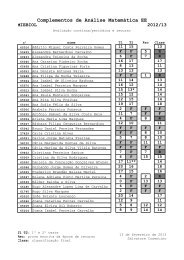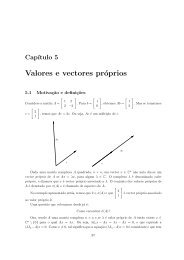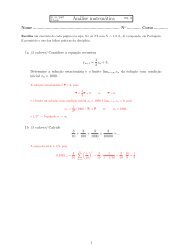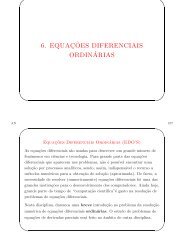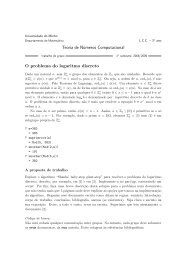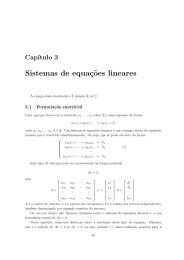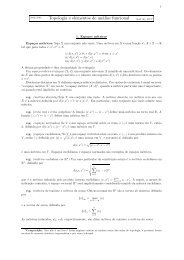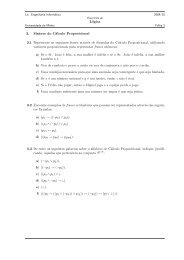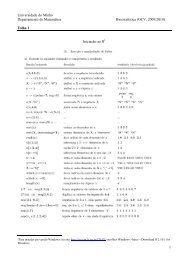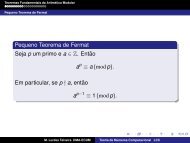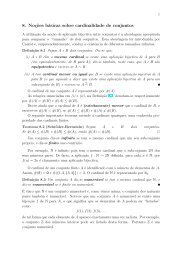My title - Departamento de Matemática da Universidade do Minho
My title - Departamento de Matemática da Universidade do Minho
My title - Departamento de Matemática da Universidade do Minho
You also want an ePaper? Increase the reach of your titles
YUMPU automatically turns print PDFs into web optimized ePapers that Google loves.
4<br />
NÚMEROS E DINÂMICA 28<br />
Construction of continued fractions representation. The recipe to get the (unique) continued<br />
fractions representation of a real number x ∈ R is as follows. First, <strong>de</strong>fine a 0 = [x], so<br />
that<br />
x = a 0 + x 0<br />
for some 0 ≤ x 0 < 1. If x 0 ≠ 0 (i.e. if x is not an integer) we may <strong>de</strong>fine r 1 = 1/x 0 , then<br />
a 1 = [1/x 0 ], and write<br />
1<br />
x = [a 0 ; r 1 ] = a 0 +<br />
a 1 + x 1<br />
for some 0 ≤ x 1 < 1. If x 1 ≠ 0, for otherwise x would be rational, we may <strong>de</strong>fine r 2 = 1/x 1 , then<br />
a 2 = [1/x 1 ] and write<br />
1<br />
x = [a 0 ; a 1 , r 2 ] = a 0 +<br />
1<br />
a 1 +<br />
a 2 + x 2<br />
for some 0 ≤ x 2 < 1. Inductively, we see that<br />
1<br />
x = [a 0 ; a 1 , a 2 , . . . , a n−1 , r n ] = a 0 +<br />
1<br />
a 1 +<br />
1<br />
a 2 +<br />
1<br />
... +<br />
a n + x n<br />
where a n = [1/x n−1 ] and x n = 1/x n−1 − a n . The algorithm stops if some x n+1 = 0, i.e. if r n is an<br />
integer, hence if<br />
x = [a 0 ; a 1 , a 2 , . . . , a n ]<br />
is racional. Conversely, if x = p/q is rational, all the r n ’s are positive rational, and have strictly<br />
<strong>de</strong>creasing <strong>de</strong>nominators (for if r n = a/b, then 1/r n+1 = r n − a n = (a − a n b)/b = c/b, and c < b<br />
because r n − a n < 1). So, there must be some first r n which is an integer, and the algorithm stops.<br />
On the other si<strong>de</strong>, if x is irrational, the x n ’s are never zero, hence all the a n ’s with n > 0 are<br />
positive integers, and x is represented by an infinite continued fraction, i.e.<br />
Exercícios.<br />
x = lim<br />
n→∞ [a 0; a 1 , a 2 , . . . , a n ] = [a 0 ; a 1 , a 2 , a 3 , . . . ]<br />
• Use the quadratic equation φ 2 − φ − 1 = 0 to show that the “ratio” φ has the simplest<br />
continued fraction, namely<br />
1 + √ 5<br />
= [1; 1, 1, 1, 1, 1, . . . ]<br />
2<br />
(observe that φ −1 = φ − 1 is a root of x 2 + x − 1 = 0, hence x = 1/(1 + 1/x), and so on). Its<br />
convergents are 1 , 2 , 3/2 , 5/3 , 8/5 , 13/8 , 21/13 , 34/21 , . . . , ratios between successive<br />
Fibonacci numbers. It is also the (irrational) number with worse rational approximations,<br />
namely |φ − p/q| > (1/ √ 5)/q 2 for any rational p/q.<br />
• Also, the most famous irrational has a simple continued fraction. Show that<br />
√<br />
2 = [1; 2, 2, 2, 2, 2, . . . ]<br />
(observe that 1 + √ 2 is the positive root of x 2 − 2x − 1. Hence x = 2 + 1/x, and so on). Its<br />
convergents are 1 , 3/2 , 7/5 , 17/12 , 41/29 , 99/70 , 239/169 , 577/408 , . . . .<br />
Gauß map. If x is irrational, the sequence (x n ) in the construction of its infinite continued<br />
fraction is the trajectory of x 0 = x − [x] un<strong>de</strong>r the Gauss map g : ]0, 1] → ]0, 1], <strong>de</strong>fined as<br />
x ↦→ 1/x − [1/x]<br />
Observe that g is not <strong>de</strong>fined at the origin, hence to iterate g we need to avoid all the preimages<br />
of 0, which are the rationals.



